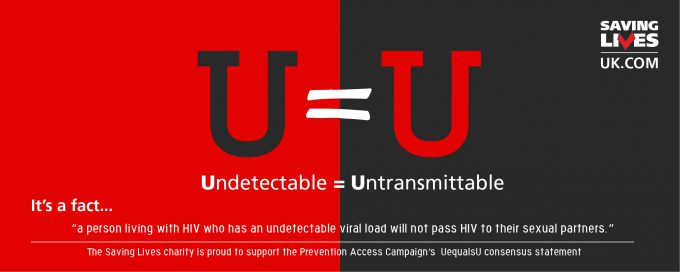
Download this information as a printable leaflet.
It’s a fact: a person living with HIV, who has an undetectable viral load, will not pass HIV to their sexual partners.
It’s over thirty years since the start of the HIV epidemic, but now new science and medical data is changing the face of HIV and improving lives of people living with, or affected by, HIV.
In 2008 a Swiss HIV researcher, named Pietro Vernazza, released a statement stating:
“An HIV-infected person on antiretroviral therapy with completely suppressed viraemia (“effective ART”) is not sexually infectious, i.e. cannot transmit HIV through sexual contact.”
The world was not quite ready for Vernazza’s vision. He drew criticism from much of the medical and scientific community. Nine years later Vernazza has been vindicated.
In 2016 we saw data from the PARTNER study. The study followed 888 sero-different couples, where one partner was HIV positive and had an undetectable viral load and the other partner was HIV negative. After six years and over 58,000 condomless sex acts later the study has reported ZERO linked partner-to-partner infections.
This year, at the International AIDS Society 2017 conference, we got even more evidence from the Opposites Attract study. This study followed 343 gay couples, where again one partner was undetectable and the other was HIV negative. The data showed once again that there were ZERO linked partner-to-partner infections.
Dr Anthony Fauci, director of the IAS National Institute for Allergies and Infectious Diseases, said:
“Scientists never like to use the word “Never” of a possible risk.
“But I think in this case we can say that the risk of transmission from an HIV-positive person who takes treatment and has an undetectable viral load may be so low as to be unmeasurable, and that’s equivalent to saying they are uninfectious. It’s an unusual situation when the overwhelming evidence base in science allows us to be confident that what we are saying is fact.”
The Prevention Access Campaign (PAC) has been working alongside the medical community to campaign for improved understanding of HIV and the benefits of early and effective treatment.
Dr Steve Taylor, Lead HIV Consultant at Heartlands HIV Service, said:
“The scientific evidence behind the U=U statement is overwhelming and people living with HIV should feel confident that if they are taking their Antiretroviral therapy (ART) consistently and have durable suppression of their viral load to undetectable levels not only will this keep them healthy, but we now know they will not transmit HIV to their sexual partners.
“This is definitely one of the most important scientific and social developments in HIV prevention in the last decade.
“Getting this message to patients and the general public is absolutely essential in order to really start fighting HIV related stigma and increase testing.
“The more people who are tested, the more people can be on life saving treatment, and in turn will get their viral loads to undetectable levels. Each step takes us closer to ending the epidemic.”
To read more about the science behind the U=U statement visit https://www.preventionaccess.org/ or www.savinglivesuk.com
The Prevention Access Campaign’s Consensus Statement follows.
People living with HIV on ART with an undetectable viral load in their blood have a negligible risk of sexual transmission of HIV. Depending on the drugs employed it may take as long as six months for the viral load to become undetectable. Continued and reliable HIV suppression requires selection of appropriate agents and excellent adherence to treatment. HIV viral suppression should be monitored to assure both personal health and public health benefits.
“NEGLIGIBLE” = so small or unimportant as to be not worth considering; insignificant.
NOTE: An undetectable HIV viral load only prevents HIV transmission to sexual partners. Condoms also help prevent HIV transmission as well as other STIs and pregnancy. The choice of HIV prevention method may be different depending upon a person’s sexual practices, circumstances and relationships. For instance, if someone is having sex with multiple partners or in a non-monogamous relationship, they might consider using condoms to prevent other STIs.
For more information please visit: https://www.preventionaccess.org/consensus
